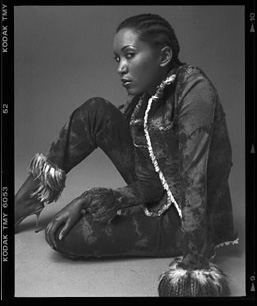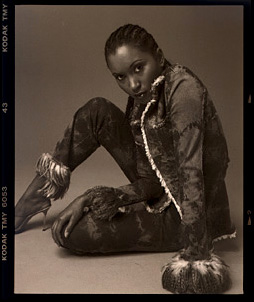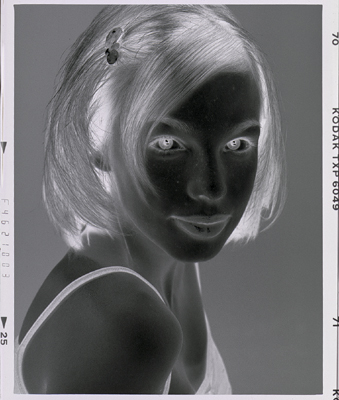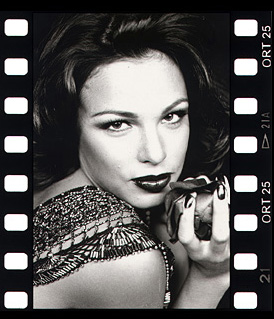 GLOSSARY
GLOSSARY
Archival / Archivability - The ability of a material to last for many years.
Ambient light - Light already existing in an indoor or outdoor situation that is not caused by any illumination.
Anti halation backing - dye used on the back of most films capable of absorbing light which passes straight through the emulsion. In this way it reduces the amount of extraneous light that can be reflected from the camera back through the emulsion.
Bracketing -Taking additional pictures of the subject through a range of exposures-both lighter and darker-when unsure of the correct exposure.
Bromide drag - which can happen when a developer has a high content of bromide- the negative will appear streaky after development
Cibachrome - (dye bleach, Ilfochrome) A positive to positive (reversal) process using three emulsion layers of silver salts sensitized to one of three colors: red, blue, or green. The image is formed by selectively bleaching dyes already existing within the paper. "Cibachrome" is the patented name given by Ilford.
Clip / Snip Test - is the means of taking a small portion of the exposed roll, processing it, then judging the balance processing time to lighten or darken the remaining exposures.
Chromogenic Film - These include sudo-Black & White films which are designed to be processed in C-41 (color) chemistry. Example: Kodak CN400, Ilford XP-2.
Color Cast - The overall bias towards one color in a mono-tone or color image. Less than 1% color cast can be seen in a mono-tone [B&W] image.
Color temperature - Description of the color of a light-source by comparing it with the color of light emitted by a (theoretical) perfect radiator at a particular temperature expressed in kelvin (K). Thus "photographic daylight" has a color temperature of about 5500K. Photographic tungsten lights have color temperatures of either 3400K or 3200K depending on their construction.
Contact Print - A print that is the same size as the negative used to produce it. A contact print is made by placing a sheet of sensitized material in direct contact with the negative. Nearly all photographic images produced prior to the 1890s were contact prints. The process was also widely used in the modern era.
Continuous-Tone - refers to an image where like colors in the subject and scene do not change abruptly; the opposite of polarization.
Contrast - the range of difference in the light to dark areas of an image.
Contrast Grade - Numbers (usually 1-5) and names (soft, medium, hard, extra-hard, and ultra hard) of the contrast grades of photographic papers, to enable you to get good prints from negatives of different contrasts. Use a low-numbered or soft contrast paper with a high contrast negative to get a print that most closely resembles the original scene. Use a high-numbered or an extra-hard paper with a low-contrast negative to get a normal contrast paper.
Contrasty - Higher-than-normal contrast including very bright and dark areas. The range of density in a negative or print is higher than it was in the original scene.
Densitometer - An instrument used for measuring the optical density of an area in a negative or print.
Density - The blackness of an area in a negative or print that determines the amount of light that will pass through it or reflect from it. Sometimes referred to as contrast.
Depth of field / DOF - Amount of distance between the nearest and farthest objects that appear acceptably sharp or close to in focus.
Developer - A solution used to turn the latent image into a visible image on exposed films or photographic papers.
Developer 1 - In dr5, producing a neutral positive image. 
Developer 2 - In dr5, producing a sepia positive image. 
Diachronic fog - purple-green bloom usually seen on negatives and caused by the formation of silver in the presence of an acid.
Di - water or De ionization - Removal of ions. The term is generally used with respect to removal of ions from water. De ionization is commonly achieved by passing the water through successive ion exchange columns. In one column, ions are exchanged for H+ ions. In another column, anions are exchanged for OH- ions. Following a reaction of H+ with OH- ions, no ions remain in solution and the result is basically "distilled water".
Digital Capture - A non-photographic means of creating an image.
Digital Camera - A non photographic means of creating an image.
Digital Photography - An Oxymoron
DIGITALSILVER - A service offered by the dr5 lab which renders interpositives, negatives & dr5 chromes from LVT film recorders.
DMAX - The darkest part of any processed film. In transparencies, dmax plays an important part in the image quality. Low dmax films produce poor images.
DMIN - The opposite of dmax.
Double negative development - incorporates '2' separate developers for producing the final image. This procedure is popular for controlling contrast in paper development [Dr. Beers]. In film, dynamic range adjustment
dr5 - http://en.wikipedia.org/wiki/Dr5 A B&W process designed to produce B&W positives from over 35 B&W films. Can also be used to process SCALA-film. The process can produce neutral or sepia transparencies in film sizes from 35mm - 11x14.
Dupe - A slide/positive exposed to film and processed in a positive process i.e.; E6, dr5.
Dynamic range - The luminance between the brightest and darkest portions of an image which is truthfully captured or observed.
Dynamic range change - While possible in most photographic processes, DRC is function to the dr5 process. This can be mainly achived by iso change.
.E6 - Kodak's standard chemical process for developing Ektachrome or compatible slide films.
Emulsion - Micro-thin layers of gelatin on film in which light-sensitive ingredients are suspended; triggered by light to create a chemical reaction resulting in a photographic image.
Emulsion Side - The side of the film coated with emulsion. In contact printing and enlarging, the emulsion side of the film-dull side-should face the emulsion side of the photo paper-shiny side.
Exposure - The quantity of light allowed to act on a photographic material; a product of the intensity (controlled by the lens opening) and the duration (controlled by the shutter speed or enlarging time) of light striking the film or paper.
Exposure Latitude - The range of camera exposures or process-time, from underexposure to overexposure that will produce acceptable pictures from a specific film.
Exposure - in photographic terms is the product of the intensity of light and the time the light is allowed to act on the film, or digital camera sensor. In practical terms, the aperture controls intensity or amount of light and shutter speed controls the time.
Exposure Index (EI) - When film is shot at something other than its rated speed setting, or ISO, The speed setting at which it is exposed is referred as the Exposure Index. For example, if Kodak Tmax 100 (TMX) Black and White film is exposed at 50, the exposure index for the film would be referred to as EI 50. Also, the EI is expressed as the "range" that a particular film can be exposed at, example; "in dr5 TXP has an EI of 20 - 320 ISO".
Evaporator - A piece of equipment that takes the water out of chemistry waste, turning it into a sludge [partial solid]. This makes waste management more economical.
Fuji Frontier - A processor-printer machine that can print on photographic paper from any medium; positives, negatives & digital files. Exposes the paper with laser-light instead of exposing optically.
File Size - the size of an image in digital photography, measured in kilobytes (KB), megabytes (MB), or gigabytes (GB). File size is proportional to its pixel dimensions; images with more pixels may produce more detail at a given printed size, but they require more disk space to store and are slower to print.
Film - photographic emulsion coated on a flexible, transparent base that records images or scenes.
Film Speed - the sensitivity of a film to light, indicated by a number such as ISO 100. The higher the number, the more sensitive or faster the film. (ISO stands for International Organization for Standardization)
Film recorder - A device used to output digital files onto film materials. CRT film recorders use a cathode ray tube and RGB filters to create the film image. Drum-based film recorders/writers "LVT" include sheet-fed and roll-fed models and use white light or lasers to record the image on film.
Filter-B&W - Anything that is placed over the front element of the lens to alter the final image is a filter. Filters range from circular polarizes, warming filter, star filters, soft focus filters, and many colored filters to change the over all color of a photograph. Filters often used in Black and White Photography and what types of effects you may see:
* Red Darkens blue skies and will improve contrast between clouds and sky. Favorable for using in text copy. Necessary when shooting Infrared film. Red filters cause blue/green/yellow to be darkened. Ad's contrast. Filter factor is 3-3.5 stops and will usually always fool "auto" metering.
* Yellow Will improve contrast between clouds and sky but to a lesser extent. Used to produce pleasant skin tones, darkens eyes & reduces freckles and blemishes in artificial light. Increases contrast in foliage. Yellow causes purple/blue/red to be darkened.
* Green Use of a green filter will produce a fair complexion in Caucasian models. Good for tonal separation in still life & best floral work. Renders red/orange/purple to be darker.
* Orange Used to darken skies. Will produce stronger contrast in the shadows. Renders green/blue/purple darker than natural.
* Blue Will enhance mist, fog & haze. Also transmitted light rays over water. A blue filter would darken reds/oranges/yellows.
Filter factor - The increased exposure needed to compensate for the amount of light absorbed by a filter. A factor of two indicates you need to give the film one stop more exposure; a factor of three needs two stops and a factor of six needs three stops more.
Flat - A scene, negative, or print with very little difference in brightness between light and dark areas.
f-Number - A number that indicates the size of the lens opening on an adjustable camera. The common f-numbers are f/1.4, f/2, f/2.8, f/4, f/5.6, f/8, f/11, f/16, and f/22. The larger the f-number, the smaller the lens opening. In this series, f/1.4 is the largest lens opening and f/22 is the smallest. Also called f-stops, they work in conjunction with shutter speeds to indicate exposure settings.
Focal Length - The distance between the film and the optical center of the lens when the lens is focused on infinity. The focal length of the lens on most adjustable cameras is marked in millimeters on the lens mount.
Fogging - Darkening or discoloring of a negative or print or lightening or discoloring of a slide caused by 1. exposure to non image-forming light to which the photographic material is sensitive, 2. too much handling in air during development, 3. over-development, 4. outdated film or paper, or 5. storage of film or paper in a hot, humid place.
Gamma - measurement used in sensitometry to describe the angle made between the straight line portion of the characteristic curve of the photograph emulsion and the base of the graph. The gamma is the tangent of the angle so formed.
Graininess - the sand-like or granular appearance of an image. Graininess becomes more pronounced with faster film and the degree of enlargement. In digital imaging, graininess may occur as a result of printing an image, the pixel resolution of which is too coarse, or as a result of using a printer with poor dot resolution.
Grayscale - term used to describe an image that only contains shades of gray
Halation - diffused ring of light typically formed around small brilliant highlight areas in the subject. It is caused by light passing straight through the emulsion and being reflected back by the film base on the light sensitive layer. This records slightly out of register with the original image.
High key - photograph which contains large areas of light tones, with few middle tomes or shadows.
Internegative - negative made on color or B&W film, for making copy prints from color or B&W slides.
Interpositive - negative made by exposing a negative to film and processing it in a positive process like dr5 or E6.
ISO /ASA Speed - The emulsion speed (sensitivity) of the film as determined by the standards of the International Standards Organization. In these standards, both arithmetic (ASA) and logarithmic (DIN) speed values are expressed in a single ISO term. For example, a film with a speed of ISO 100/21° would have a speed of ASA 100 or 21 DIN.
Keeping codes - Term used to describe the lab keeping the clients number codes, roll to roll.
KELVIN scale - Apparent color temperature of a light source indicates its degree of blueness or redness as we view it. The higher the number, the bluer the light appears; the lower the number, the more red the light looks. A candle flame has an apparent color temperature of about 1800 degrees Kelvin, incandescent lamps are about 2900K, cool white fluorescent are about 4200K and an overcast sky appears about 6500K. The Kelvin scale gives no indication about color rendering. It does not tell you how accurately colors will appear under a particular light source.
Lantern slides - old term used to describe transparencies.
Large format camera - general term for any camera having a picture format of 4 x 5 inches or larger.
Latent Image - The invisible image left by the action of light on photographic film or paper.
Latitude - degree by which exposure can be varied and still produce an acceptable image. The degree of latitude varies by film type. Faster films tend to have greater latitude than slower films.
Low key - photograph in which tones are predominantly dark and there are few highlights.
LVT - (Light-Value-Transfer) The LVT RHINO+ Image recorder, originally made by Kodak, is a dependable, state of the art, variable resolution image recorder that produces high-resolution images on a variety of photographic materials (color transparency, color negative, black and white negative or photographic paper) to yield a "traditional" copy of any digital image file.
Monochrome - is single colored. It is most frequently applied to black and white photographs, but can also describe sepia and other toned images. Monochromatic are light rays of a single wavelength.
Mottling - is a processing fault characterized by random print density differences.
Negative - The developed film that contains a reversed tone image of the original scene. 
Neutral Gray Card - a gray test card without any hue, typically of 18% reflectance.
Neutral White Card - a white test card without any hue, typically of 90% reflectance.
Orthochromatic - Denotes film sensitive to blue and green light.
Overexposure - A condition in which too much light reaches the film, producing a dense negative or a very bright/light print or slide.
Pixelization - the graininess in an image that results when the pixels are too big, relative to the size of the image.
Positive - the opposite of a negative, an image with the same tonal relationships as those in the original scenes, for example, a finished print.
Panchromatic - Designation of films that record all colors in tones of about the same relative brightness as the human eye sees in the original scene, sensitive to all visible wave-lengths.
Platinum/Palladium - A printing process in which images are formed in platinum or palladium by placing a negative on paper sensitized, either by hand or pre-coated, with a solution of platinum or palladium and iron salts, exposed to light, and then developed in Potassium oxalate. Platinum/Palladium prints are thought to be more permanent than silver prints and allow for a very large tonal scale (numerous tones of gray).
Photography - 1. The process or art of producing images of objects on sensitized surfaces by the chemical action of light or of other forms of radiant energy, as x-rays, gamma rays, or cosmic rays. 2. literally writing or drawing with light (from the Greek words photos meaning light and graphics, writing). First suggested by Sir John Herschel to William Fox Talbot in 1839.
Push / Pull Processing - Increasing or decreasing the development time of a film to change its effective speed (raising the ISO number for initial exposure ) for low/bright-light situations; forced development.
RGB - the way that the colors are recorded in digital imaging. A large percentage of the visible spectrum can be represented by mixing red, green and blue (RGB) colored light in various proportions and intensities.
Reciprocity - Most films are designed to be exposed within a certain range of exposure times-usually between 1/15 second to 1/1000 second. When exposure times fall outside of this range-becoming either significantly longer or shorter-a film's characteristics may change. Loss of effective film speed, contrast changes, and (with color films) color shifts are the three common results. These changes are called reciprocity effect.
Reticulation - Cracking or distorting of the emulsion during processing, usually caused by wide temperature or chemical-activity differences between the solutions.
Reflectance - the light intensity emitted from a surface in a given direction.
Resolution - refers to a measure of the detail that can be seen in an image; the higher the resolution, the finer the detail that can be seen.
Scala- is a B&W ortho-clear-base film type made by AGFAphoto for creating B&W slides. The film and process are now discontinued.
Silver - The principal use of silver is as a precious metal. Its salts, especially silver nitrate and silver halides, are widely used in photography, which is the largest single end use of silver.
Silver Halide - Compounds formed between silver and one of the halogens, usually silver bromide (AgBr), silver chloride (AgCl) and silver iodide. Silver halide crystal is exposed to light, a sensitivity speck on the surface of the crystal is turned into a small speck of metallic silver, these comprise the invisible or latent image. If the speck of silver contains approximately four or more atoms, it is rendered developable. It can undergo development which turns the entire crystal into metallic silver.
Slide - A photographic transparency (positive) mounted for projection.
Solarization - reversal or partial reversal of tones in a photographic image caused by vast amounts of over-exposure. It is often inaccurately used to describe the partial reversal effect caused by fogging photographic material with light, which is actually the Sabattier effect.
Under-exposure / Down - refers to a condition where too little light reaches the film or digital camera sensor, either because the light is not sufficient or it hasn't been applied long enough; it results in a very dark photograph.
Transparency - A positive photographic image on film, viewed or projected by transmitted light (light shining through film).
Zone system - is the method of determining exposure and development required for individual scenes, invented by Ansel Adams. It is based on analysis of subject luminosities in terms of ten gray tones, labeled zones 0 through X and pre visualizing them as print densities. By measuring each subject luminance with a hand meter it is possible to determine how much the range of values must be contracted or expanded by negative development control to give the required values in the print.
FACT FILLED TECH PAGE SHIPPING UPDATES & DISCOUNTS dr5 vs. XTOL-negative Comparisons glossary
![]() dr5 FILM-REVIEW
dr5 FILM-REVIEW ![]() Independent dr5 tests ORDER-PRINT-OUT CALENDAR
Independent dr5 tests ORDER-PRINT-OUT CALENDAR